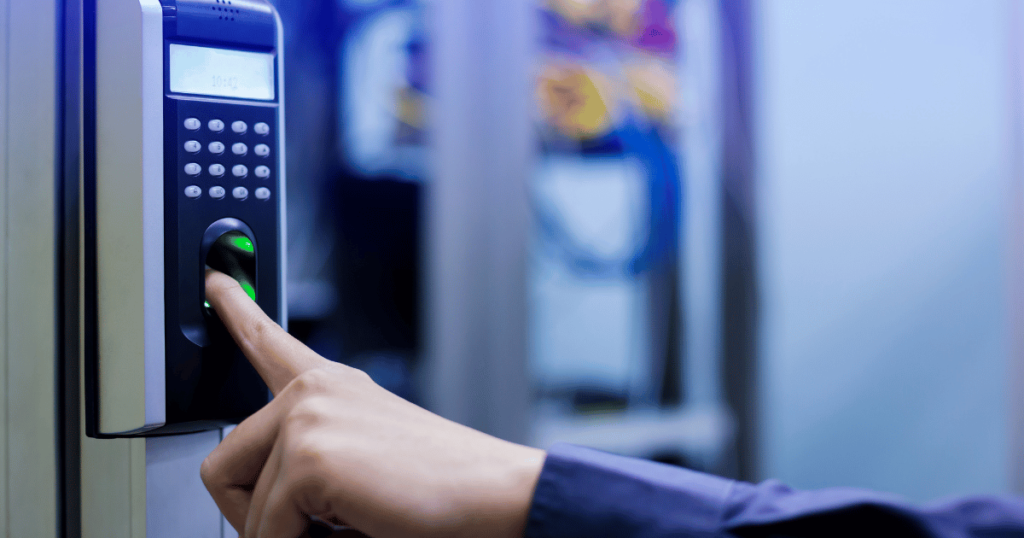
Fingerprint Scan – Secure Your Identity with Advanced Authentication Technology
Fingerprint scanning is a biometric authentication method that captures and analyzes the distinct patterns of ridges and valleys on a person’s fingertips to verify their identity. What makes this technology remarkable is that no two individuals—not even identical twins—have the same fingerprint patterns, making it an exceptionally reliable form of identification.
At its core, fingerprint scanning creates a digital representation of your unique fingerprint characteristics. Modern fingerprint solutions detect minute details like ridge endings, bifurcations (where ridges split), and unusual patterns that collectively form what security experts call “minutiae points.” These distinctive features serve as the foundation for all fingerprinting solutions in the market today.
The technology has achieved remarkable accuracy levels, with premium fingerprint scanning systems reaching 98.6-99.9% accuracy rates in single-finger authentication tests according to NIST evaluations. This impressive precision, combined with the speed and non-invasive nature of the process, explains why fingerprint scanning has become the preferred biometric verification method across numerous industries and applications.
Ready to experience unparalleled security with the convenience of a simple touch? Contact us to try SPADE’s fingerprint scanning solutions today.
LiveScan & Fingerprinting Services
Brief History and Evolution of Fingerprint Scanning
The journey of fingerprint scanning has evolved from simple impressions to advanced digital identification systems. Although fingerprints have been recognized for their uniqueness for thousands of years, modern fingerprinting began in the mid-19th century. In 1858, Sir William James Herschel used fingerprints for contracts in India, marking an early application as personal identifiers. The field progressed further in 1892 when Inspector Eduardo Alvarez in Argentina used fingerprints to solve a murder case.
By 1924, the FBI established the first centralized fingerprint repository in the U.S. with over 810,000 cards. A major advancement came in 1975 with the development of the first automated fingerprint scanners, transitioning from manual comparison to computer-assisted processes. The digital era truly began in 1999 when the FBI launched the Integrated Automated Fingerprint Identification System (IAFIS), significantly speeding up identification times from weeks to hours.
Today’s advanced fingerprint scanning technology continues this evolution with the integration of artificial intelligence and machine learning algorithms into automated fingerprint identification systems (AFIS), enhancing accuracy and efficiency. These systems can now automatically extract fingerprint image features, eliminating manual labor and speeding up matching times. According to recent research, the global automated fingerprint identification system market was valued at USD 8.14 billion in 2023 and is projected to grow at a CAGR of 19.1% from 2024 to 2030.
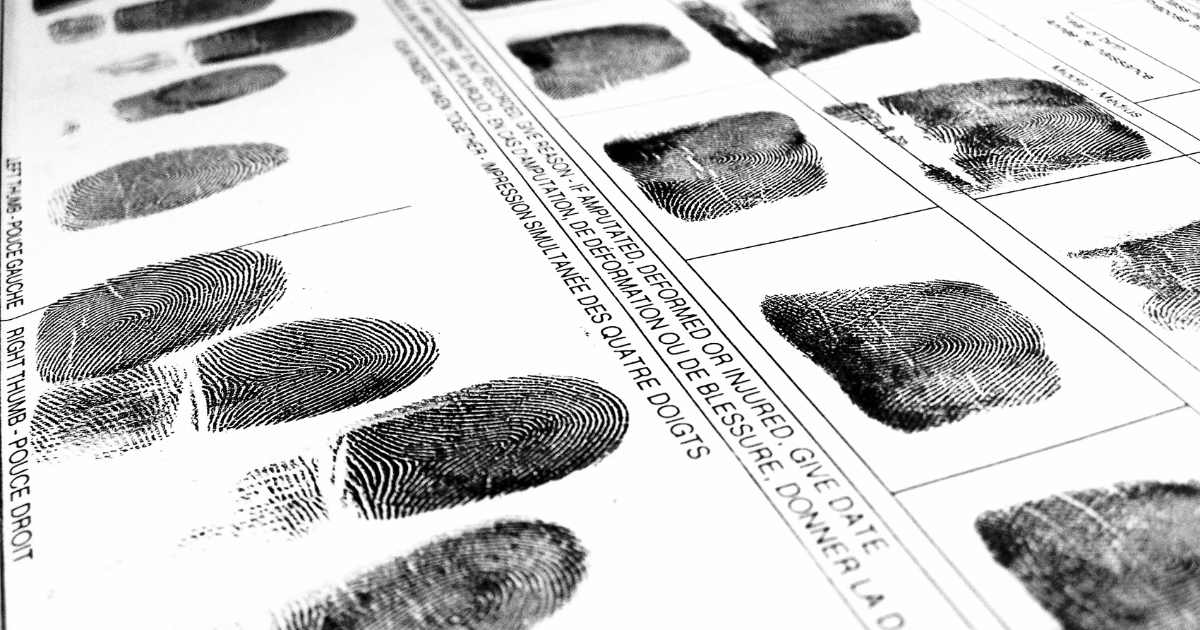
Types of Fingerprint Scanners
The market offers diverse fingerprint solutions catering to different security needs, each with unique operating principles and applications. Understanding these differences helps organizations select the most appropriate technology for their specific requirements.
Optical Scanners
Optical scanners represent one of the most established fingerprint solutions in the market. These devices use LED lights to illuminate the finger’s surface while a charged coupled device (CCD) captures the reflected light pattern created by the ridges and valleys of your fingerprint.
The primary advantages of optical scanners include their affordability, durability, and minimal maintenance requirements. They typically feature larger scanning areas, allowing for higher-resolution images that capture more minutiae points for comparison. However, they aren’t without limitations—optical scanners can be vulnerable to spoofing with high-quality fingerprint replicas and their performance degrades when encountering dirt, moisture, or damaged skin. Their larger form factor also makes them less suitable for compact devices.
Capacitive Scanners
Capacitive scanners function on electrical principles rather than light. When a finger touches the sensor surface, these scanners measure the tiny electrical differences between the ridges (which make contact) and valleys (which don’t) of the fingerprint. This creates an electrical map that serves as the fingerprint template.
The technology shines in mobile applications due to its compact size and fast scanning speed. Capacitive scanners also offer enhanced security against fake fingerprints since they require actual physical characteristics beyond visual patterns. The downside is their sensitivity to electrostatic discharge and difficulty reading extremely dry or wet fingers. They also typically cost more than their optical counterparts.
Ultrasonic Scanners
Representing the cutting edge of fingerprinting solutions, ultrasonic scanners emit sound waves and measure how they bounce back from the finger’s surface. This creates a detailed three-dimensional map of the fingerprint, capturing depth information that other technologies miss.
Ultrasound-based fingerprint scanning has emerged as a game-changer in recent years, offering touchless authentication that is faster and more hygienic. This technology improves accuracy by reading deeper into the skin’s layers, reducing misreads significantly. Many modern smartphones now incorporate ultrasonic sensors beneath display glass, enabling “through-display” fingerprint reading. However, this advanced technology comes with higher costs, slower scanning speeds, and occasional compatibility issues with certain screen protectors.
Thermal Scanners
Thermal fingerprint scanners detect temperature differences between the ridges and air-filled valleys of fingerprints. As the finger touches the pyroelectric material in the scanner, it generates a thermal image representing the fingerprint pattern.
These scanners excel in liveness detection by measuring actual skin temperature, making them highly resistant to spoofing attempts using artificial fingerprints. They also perform well when surface contaminants are present. However, thermal scanners tend to be expensive, are sensitive to ambient temperature fluctuations, and remain relatively uncommon in consumer devices.
LiveScan
LiveScan represents a significant evolution from traditional ink fingerprinting methods. As a modern, electronic capture system, LiveScan digitally records fingerprints without messy inks or papers. The technology uses either optical, capacitive, or ultrasonic methods to create digital fingerprint images that can be immediately transmitted to identification databases.
What distinguishes LiveScan from other fingerprint solutions is its role in large-scale identity management systems. It offers substantially faster processing times—reducing identification waits from weeks to minutes—and significantly higher quality images that result in fewer rejection rates due to poor print quality. Law enforcement agencies, immigration services, and background check companies have widely adopted LiveScan technology despite its higher initial equipment costs and specialized operator training requirements.
How Fingerprint Scanning Works
Fingerprint scanning operates through a sophisticated process that transforms unique physical traits into secure digital identifiers. Understanding how fingerprinting works reveals why this technology has become a cornerstone of modern security systems.
Image Capture
The journey begins with image capture—the critical first step in fingerprint processing. When you place your finger on a scanner, the device employs one of several sensing technologies to create a digital representation of your fingerprint:
Optical scanners use LED lights to illuminate the finger while cameras capture the resulting light pattern. Capacitive sensors measure tiny electrical differences between ridges and valleys. Ultrasonic devices send sound waves that penetrate the skin’s surface, creating detailed 3D maps. Regardless of the technology used, the goal remains consistent: generating a high-quality digital image that accurately represents your unique fingerprint pattern.
Modern fingerprint scanning systems don’t just passively accept whatever image quality they receive. Advanced preprocessing algorithms automatically enhance image clarity by adjusting contrast, removing background noise, and optimizing ridge definition. This enhancement stage compensates for common issues like dry skin, excess moisture, or slight finger placement variance—ensuring the highest quality input for subsequent processing steps.
Template Generation
Once a clear image is captured, the system begins the most intellectually sophisticated part of fingerprint processing: feature extraction and template creation. This stage transforms a simple image into a mathematical representation of your unique fingerprint.
The software identifies distinctive fingerprint characteristics—primarily minutiae points where ridges end, fork, or form islands. These characteristics create a complex pattern unique to each individual. Advanced AI and machine learning algorithms have revolutionized this process, enabling systems to accurately detect and map these features even from partial or imperfect prints.
The extracted features undergo conversion into a mathematical template—essentially a string of encrypted code that represents your fingerprint’s unique attributes. This template typically requires only 250-1000 bytes of storage, far less than the original image. Importantly, this mathematical representation is one-way; your actual fingerprint image cannot be reconstructed from the template, providing critical privacy protection.
Matching and Verification
The final phase illustrates practical fingerprinting applications by comparing captured fingerprints against stored templates for identity verification. When needed, a new fingerprint sample is captured, a template generated, and then compared to existing ones.
Modern algorithms use advanced pattern recognition to calculate similarity scores while accommodating natural variations in scans. The process concludes with a simple match or no match decision, usually in under a second. Administrators can adjust sensitivity thresholds to balance security with user convenience.
Recent innovations like 3D imaging and quantum computing are enhancing fingerprint processing, improving both security and convenience in identity verification.
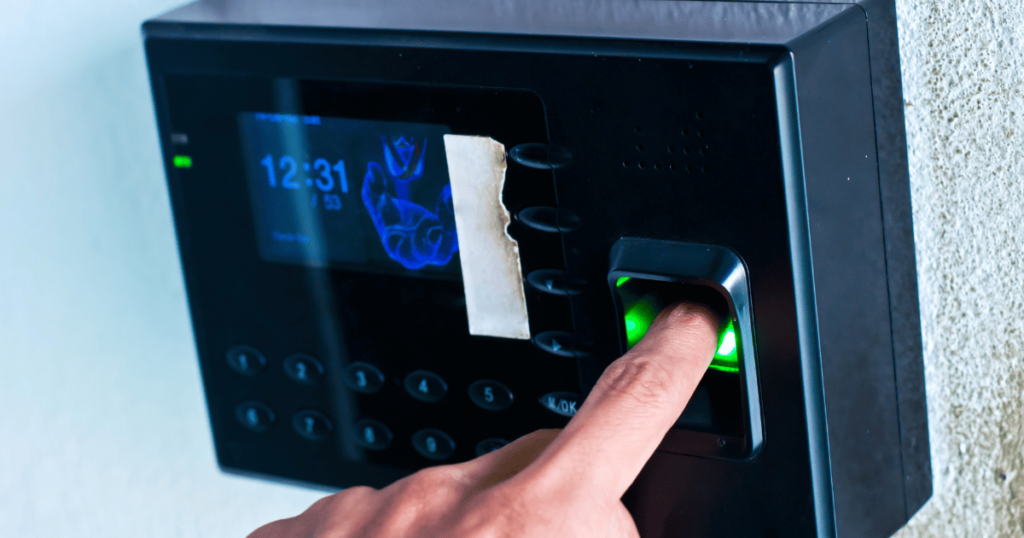
Common Applications of Fingerprint Scanning
Fingerprint scanning has evolved from niche security applications to become a mainstream technology that impacts our daily lives. The versatility of fingerprint solutions has led to their integration across numerous sectors, each leveraging the unique advantages of this biometric identifier.
Security Systems
Physical access control represents one of the most established applications of fingerprint security. Modern buildings, data centers, and restricted areas increasingly rely on fingerprint scanning to regulate entry, replacing traditional keys and access cards with biometric authentication. This shift provides several advantages: credentials cannot be forgotten, lost, or easily transferred to unauthorized individuals.
High-security facilities often implement multi-factor authentication systems that combine fingerprint scanning with additional verification methods such as PIN codes or access cards. This layered approach significantly enhances security by requiring something you have (card), something you know (PIN), and something you are (fingerprint). Banking institutions have particularly embraced fingerprint solutions for vault access and safety deposit boxes, as they provide both enhanced security and a comprehensive audit trail of all access attempts.
Mobile Devices
The integration of fingerprint scanning into smartphones and tablets has perhaps done the most to normalize this technology for everyday users. Since Apple introduced Touch ID in 2013, followed by competitors with similar features, billions of people have grown accustomed to unlocking their devices and authorizing purchases with a simple finger touch.
Beyond mere convenience, fingerprint security on mobile devices has significantly improved digital security posture for the average user. Before fingerprint authentication, many users avoided using any screen lock due to the inconvenience of repeatedly entering PINs or patterns. The fingerprint scanner’s speed and reliability encouraged widespread adoption of device security measures, protecting sensitive personal data and communications from unauthorized access.
The mobile payment ecosystem has particularly benefited from fingerprint scanning technology, with services like Apple Pay, Google Pay, and banking apps using fingerprint verification to authorize transactions. This has created a more seamless yet secure payment experience that significantly reduces friction in the checkout process while maintaining robust security.
Law Enforcement and Forensics
Law enforcement continues to represent the most comprehensive application of fingerprint scanning technology. Modern police departments rely on sophisticated fingerprint solutions that can rapidly search and match prints against databases containing millions of records. The FBI’s Next Generation Identification system can process thousands of fingerprint comparisons per second with remarkable accuracy.
LiveScan technology has revolutionized the booking process in law enforcement, allowing for immediate digital capture and transmission of fingerprints to national databases. This system is now widely used beyond criminal processing for background checks, licensing requirements, and other legal verifications. The speed and accuracy of LiveScan has dramatically reduced processing times for everything from employment screening to adoption applications.
Forensic investigators employ advanced fingerprint scanning techniques at crime scenes, including specialized equipment that can detect and capture latent fingerprints invisible to the naked eye. New technologies can even recover fingerprints from surfaces previously considered impossible, such as certain fabrics, bullet casings, and items exposed to extreme heat or water.
Attendance and Workforce Management
Organizations across industries have adopted fingerprint scanning systems for time and attendance tracking, replacing easily manipulated punch cards and buddy-punching issues with biometric verification. These systems ensure accurate records of employee work hours while simultaneously simplifying the payroll process.
Healthcare facilities use fingerprint security to manage access to medication dispensing systems and restricted areas, creating accountability and securing sensitive locations. Educational institutions implement fingerprint scanning for tracking student attendance and managing access to dormitories and specialized facilities.
The manufacturing sector has particularly benefited from fingerprint solutions that integrate with safety protocols. In high-risk environments, machinery can be programmed to operate only when authorized personnel are present and have been verified through fingerprint scanning, preventing untrained individuals from operating dangerous equipment.
Standards and Compliance
Implementing fingerprint biometric systems requires adherence to established standards and compliance frameworks to ensure security, interoperability, and legal compliance. At SPADE Security Services, we design all our solutions to meet or exceed these critical requirements.
NIST Standards Compliance
Our fingerprint solutions fully comply with key NIST standards that define the foundation for secure and interoperable biometric systems:
- NIST Special Publication 800-76-2: We adhere to these technical specifications for biometric data used in Personal Identity Verification (PIV) systems, including fingerprint image quality standards, minutiae extraction algorithms, and interoperability requirements.
- ANSI/NIST-ITL 1-2011: Our systems implement this data exchange standard to ensure fingerprint data can be shared across jurisdictions and between systems from different manufacturers when necessary and authorized.
ISO/IEC Certification
SPADE Security Services maintains ISO/IEC compliance for all fingerprint biometric implementations:
- ISO/IEC 24741:2024: Our solutions follow the latest guidance on international standards for biometric implementation, including proper capture techniques across all scanner types.
- ISO/IEC 19794-2: We strictly adhere to this standard for representing fingerprint minutiae data, ensuring maximum interoperability.
Expert Insight: “Compliance isn’t just about checking boxes—it’s about implementing security that works in the real world while meeting rigorous standards. At SPADE, we design our fingerprint solutions to exceed minimum requirements, providing our clients with future-proof security that adapts to evolving standards.” – Pranil Shankar, SPADE Security Services
Regulatory Frameworks
Our implementation process includes comprehensive regulatory compliance assessment for:
- PCI DSS 4.0: For clients in the payment industry, our fingerprint solutions incorporate continuous threat modeling and multi-factor authentication that meets the latest requirements.
- GDPR and CCPA: All SPADE fingerprint implementations include the necessary consent mechanisms, data minimization practices, and security measures to comply with privacy regulations.
- Industry-Specific Regulations: We provide specialized compliance solutions for healthcare (HIPAA), financial services, and government security requirements.
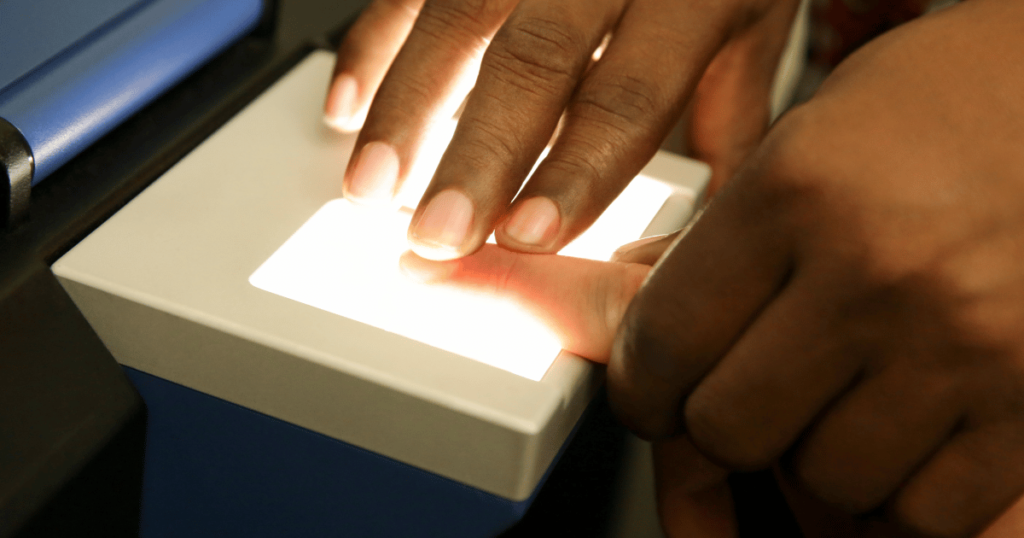
Benefits of Using Fingerprint Scanners
Organizations and individuals increasingly gravitate toward fingerprint security systems not merely because of technological fascination, but because these solutions deliver tangible advantages over conventional identification methods. Understanding these benefits helps decision-makers evaluate whether fingerprint solutions align with their specific needs.
High Accuracy
The accuracy of fingerprint solutions is due to the unique biological characteristics of fingerprints, with about 150 ridge features per fingerprint. Modern systems analyze 30-40 points for comparison, resulting in a false match probability of approximately 1 in 64 billion, significantly outperforming traditional methods like passwords. High-end fingerprint systems achieve error rates below 0.001%, ensuring that only authorized users gain access while keeping unauthorized individuals out.
This reliability is consistent across various demographic groups, making it a key element in security systems for sensitive information. Additionally, modern solutions adapt to factors like finger placement, pressure differences, and environmental conditions, allowing them to match partial fingerprints and compensate for temporary issues like dry skin.
Convenience and Speed
The frictionless user experience offered by fingerprint solutions significantly enhances adoption rates compared to other security measures. Authentication occurs in under a second—faster than entering even a simple password—and requires minimal user training. This speed advantage becomes particularly meaningful in high-traffic environments where even small delays multiply into significant productivity losses.
Beyond speed, fingerprint scanning eliminates frustrating authentication failures common with knowledge-based systems. Users never “forget” their fingerprints as they might passwords, nor can they misplace them like access cards or physical keys. This intrinsic connection between user and credential dramatically reduces help desk calls, password resets, and replacement costs for lost access mechanisms.
The integration of fingerprint security into everyday devices has normalized this technology, reducing user resistance compared to other biometric approaches that might feel more invasive or unfamiliar. This psychological acceptance translates into smoother implementation and higher compliance with security protocols—a critical factor for organizations seeking to strengthen security without disrupting workflows.
Cost-Effectiveness
While the initial investment in fingerprint solutions may exceed traditional security systems, their long-term economic advantages often deliver compelling return on investment. The elimination of ongoing expenses for printed ID cards, password management systems, and physical key infrastructure generates substantial operational savings over time.
Reduced administrative overhead represents another significant cost advantage. Organizations implementing fingerprint security systems typically report 70-80% reductions in time spent managing access credentials. The self-contained nature of fingerprint authentication eliminates resource-intensive processes like issuing temporary passwords, replacing lost access cards, or rekeying locks when keys disappear.
Security breaches carry enormous financial implications—averaging $4.35 million per incident according to recent industry reports. By significantly reducing unauthorized access incidents, fingerprint solutions offer implicit financial protection through risk mitigation. For regulated industries facing compliance requirements, these systems also help avoid potential fines and penalties associated with inadequate access controls.
Challenges and Limitations
While fingerprint security offers compelling advantages, responsible implementation requires understanding its inherent limitations. Despite significant technological advances, fingerprint solutions continue to face several challenges that can impact their effectiveness in certain contexts.
Privacy Concerns
The immutable nature of fingerprints creates unique privacy considerations. Unlike passwords that can be changed if compromised, fingerprints represent permanent biological identifiers. This permanence raises significant questions about data protection and potential misuse that extend beyond typical security concerns.
Data breaches involving fingerprint databases pose particularly serious risks. Several high-profile incidents have exposed millions of fingerprint records, including a 2019 breach where researchers discovered 27.8 million biometric records exposed on an unsecured database. Since individuals cannot “reset” their fingerprints, such compromises potentially create lifetime vulnerability to identity theft.
How SPADE Addresses This Challenge: SPADE Security Services implements strict encrypted storage protocols that convert fingerprint data into one-way mathematical templates that cannot be reverse-engineered into actual fingerprint images. We maintain complete separation between biometric templates and personal identifying information, and our systems include automatic purging mechanisms when access privileges expire.
Skin Condition Variability
The physical condition of a user’s fingers can significantly impact the reliability of fingerprint solutions. Research indicates that approximately 15% of the global population suffers from hand dermatitis, which can substantially alter fingerprint patterns or prevent successful scanning altogether. Beyond chronic conditions, numerous temporary factors affect fingerprint recognition, including extreme dryness, cuts, excessive moisture, and age-related changes.
How SPADE Addresses This Challenge: Our enterprise solutions incorporate adaptive enrollment that captures multiple fingerprints per user and employs AI algorithms that continuously update stored templates to account for gradual changes in finger characteristics. We also implement alternative authentication methods as backups for users with temporary or permanent conditions affecting fingerprint readability.
Spoofing Risks
Despite technological advances, fingerprint solutions remain vulnerable to sophisticated spoofing attacks. Presentation attacks—where artificial fingerprints created from latent prints or photos are used to deceive scanners—represent the most common spoofing method.
How SPADE Addresses This Challenge: SPADE implements multi-layered anti-spoofing technologies in all our fingerprint systems, including advanced liveness detection that verifies blood flow, subsurface fingerprint characteristics, and electrical conductivity measurements that differentiate between living tissue and artificial materials. For high-security installations, we recommend multi-factor authentication combining fingerprints with other verification methods.
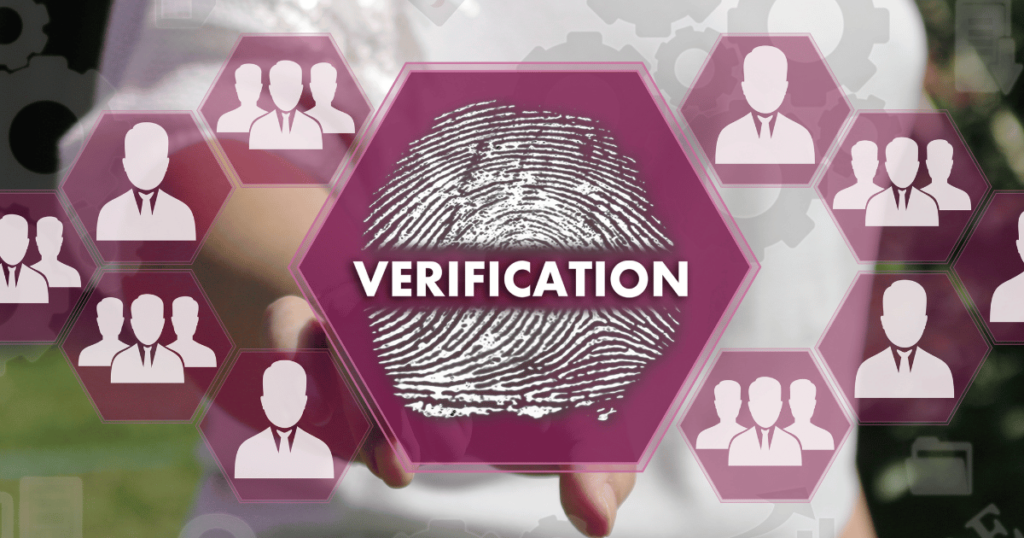
Implementing Fingerprint Scanning in Your Organization
Integrating fingerprint scanning technology into your organizational infrastructure requires careful planning and execution. This systematic approach ensures that your biometric system enhances security without disrupting operations or creating compliance issues.
Considering Security Needs
The foundation of successful implementation begins with a thorough security assessment. Different organizations face varying threat profiles that directly influence scanner selection. Healthcare institutions handling protected health information require higher security thresholds than retail environments managing employee time tracking. Begin by identifying your most vulnerable access points and critical assets requiring protection.
Resolution quality stands as a pivotal technical consideration. Higher resolution scanners (minimum 500 dpi) capture more minutiae points, enhancing matching accuracy but increasing costs. Organizations with heightened security concerns should prioritize fingerprint solutions offering liveness detection capabilities that prevent spoofing attempts using artificial fingerprints.
When evaluating potential fingerprint service providers, request their False Acceptance Rate (FAR) and False Rejection Rate (FRR) metrics. These statistics offer concrete insights into system reliability. Reputable fingerprint vendors should provide transparent performance metrics across diverse user populations and environmental conditions.
Cost and Budget Considerations
Fingerprint scanning implementation involves several cost categories beyond initial hardware expenses. A comprehensive budget should include:
- Scanner hardware (typically $50-300 per unit for standard commercial devices)
- Backend infrastructure, including servers and secure storage systems
- Software licensing and ongoing subscription fees
- Integration services to connect with existing systems
- Staff training and user enrollment time
- Regular maintenance and eventual hardware replacement
Consider total cost of ownership rather than focusing exclusively on initial acquisition costs. Some fingerprint solutions offer attractive upfront pricing but impose substantial ongoing maintenance fees or expensive proprietary components. Request a detailed breakdown of all recurring costs when evaluating fingerprint vendor proposals.
Organizations with limited budgets might consider phased implementation approaches, prioritizing high-security areas initially while expanding coverage as resources permit. Cloud-based biometric services can reduce upfront infrastructure costs but may introduce additional compliance considerations regarding data storage locations.
Conclusion: Fingerprint Authentication with SPADE Security Services
Fingerprint scanning technology stands at a fascinating intersection of biology, mathematics, and computer science—transforming unique physical characteristics into powerful digital identifiers. As we’ve explored throughout this article, these systems offer compelling advantages in security, convenience, and operational efficiency that explain their growing adoption across diverse applications.
At SPADE Security Services, we remain at the forefront of these technological advancements, continuously enhancing our fingerprint authentication offerings to provide our clients with the most secure, convenient, and compliant solutions available. Our team of certified security professionals brings decades of collective experience implementing biometric systems across industries ranging from healthcare and finance to manufacturing and government.
Taking the Next Step with SPADE Security Services
Ready to explore how fingerprint authentication can enhance your organization’s security posture? SPADE Security Services offers several ways to begin your biometric security journey:
- Security Assessment: Request a comprehensive evaluation of your current security systems and potential fingerprint integration points.
- Solution Demonstration: Schedule an in-person or virtual demonstration of our fingerprint authentication technologies tailored to your industry.
- Consultation Services: Speak with our biometric security experts about your specific challenges and objectives.
- Custom Implementation Proposal: Receive a detailed proposal outlining recommended solutions, implementation timeline, and expected outcomes.
Tired of clunky fingerprint systems that slow down your operations or basic solutions that leave security gaps? SPADE’s advanced fingerprint authentication eliminates this frustrating trade-off. Get military-grade security that keeps your business moving at the speed of business. Contact us today for a seamless integration that won’t disrupt your workflow.

